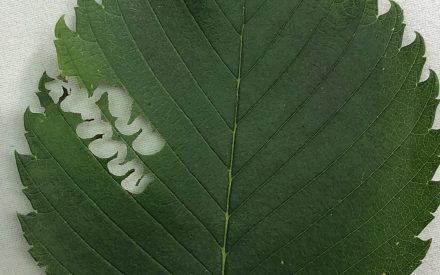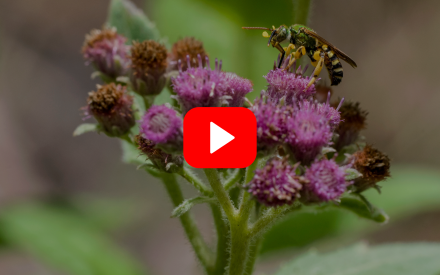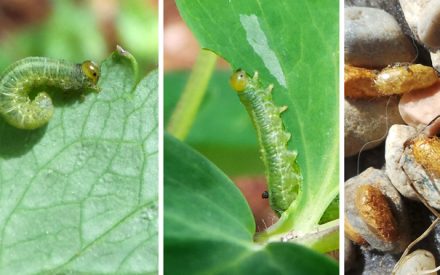
The family Staphylinidae, or rove beetles, is the largest family of North American beetles, with about 4000 species. Most are small and of cryptic habits and although common, the group as a whole is difficult to study. Some species are predaceous as both adults and larvae; the larvae of other species are parasitoids; many others are probably scavengers. They are often found in agricultural soils and home gardens.
Adult rove beetles are typically less than 3/4 inch long, with many species being 1/4 inch or less. They are easily recognized by their slender, usually black or brown body, shortened front wings (elytra) that may look like pads on the abdomen, and behavior of curling the tip of the abdomen upwards when disturbed or running. The adults can be confused with earwigs, which have moveable forceps at the end of the abdomen, whereas these beetles do not. Adults are usually strong fliers. Most species are nocturnal, but a few, such as Stenus and Paederus, are active during the day. The mobile larvae of nonparasitic rove beetles may be distinctly segmented. Larvae of Stenus, Astenus, and some other species spin a cocoon before pupating. In general, adults are relatively long-lived.
Most rove beetles are found in moist habitats in association with soil or decaying organic matter. They may be seen under debris or rocks, in compost piles, or crawling on plants. Adults have even been found in sweet corn tassels and silks late in the season! Some species are predators of the various stages of flies that infest dead animals, so these beetles are often associated with carrion even though they may not be feeding directly on the remains.
Predaceous rove beetles, depending on the species, may consume root maggot eggs and larvae, mites, small soil insects such as springtails, insect eggs, or small insects on foliage. Some feed on the eggs and maggots of filth flies. Several occur in agricultural soils where they probably feed on a variety of types of prey. A few species can be found in vegetation where they feed on many types of small insects and mites.
Aleochara bilineata, a species with parasitic larvae, is a relatively well-studied natural enemy of some root maggots. This species was introduced from Europe into North America probably with one of its hosts, the cabbage maggot. The beetles are 1/8 inch in size, and they attack cabbage maggots in the pupal stage. The adults are glossy black except for the short wing covers, which are a reddish brown. They emerge in spring and deposit eggs in the soil near the roots of maggot-infested plants. When the beetle larvae hatch in 5 to 10 days, they actively search out host puparia in the surrounding soil. They gnaw a hole in the shell, enter and feed externally on the maggot pupae for about 3 weeks. Beetle pupation occurs within the host puparia, and adults emerge after a month or more. Another very similar beetle, A. bipustulata, occurs in small numbers in some areas. It has the same general life cycle as A. bilineata.
Aleochara adults are predators, destroying eggs or young maggots near the soil surface and maggots in the plant roots. They may consume up to 5 root maggot larvae per day, with a pair being capable of destroying 1200 eggs and 130 larvae, plus parasitizing several hundred pupae, during their lifetime.
Although they are good predators and parasitoids of root maggots, they often do not emerge early enough in the spring to have an impact on early season root maggot damage. In an extensive survey throughout Canada, parasitism of cabbage maggot by A. bilineata ranged from 0% to 63% at different locations. Late season parasitism of cabbage maggot pupae may be as high as 90-95% in some areas.
Although not currently commercially available in North America, this species has been mass reared in Europe, the former Soviet Union, and Canada. It may someday be possible to augment natural populations of rove beetles for early season root maggot control. In other cases, some rove beetle species are commercially available to help manage certain pests in greenhouse settings.
Original by Susan Mahr, UW – Madison. Updated by PJ Liesch, UW-Entomology.
February, 2025





 Elm Zigzag Sawfly
Elm Zigzag Sawfly ▶ Watch: How do Pesticides Affect Pollinators and Songbirds in Your Yard
▶ Watch: How do Pesticides Affect Pollinators and Songbirds in Your Yard ▶ Watch: Pollinator Gardens: Plant Selection and Garden Care
▶ Watch: Pollinator Gardens: Plant Selection and Garden Care Strategies for Identifying and Managing Insect Pests
Strategies for Identifying and Managing Insect Pests


